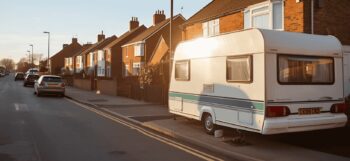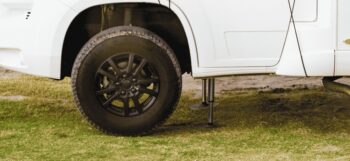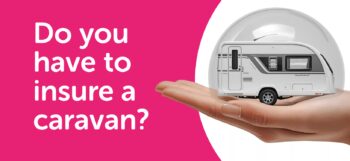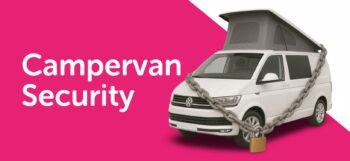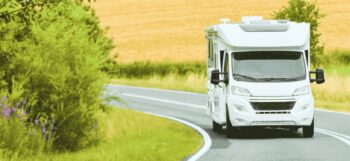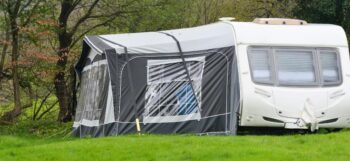Owning a motorhome means limitless adventures—along with various safety and security concerns. Motorhomes are valuable investments and often carry personal belongings, making them attractive targets for theft. Plus, the more miles you put on the clock, the higher the risk of wear and tear—both of which can put you and your passengers at risk.
Keeping your motorhome safe and secure is essential for worry-free journeys. That’s why we’ve put together a comprehensive guide with practical motorhome security tips to help keep your motorhome fit for driving, wherever you’re headed.
Motorhome vehicle safety
Maintaining your motorhome is vital for protecting your safety. Here are some key motorhome security considerations to keep it in top condition.
Tyres
Tyres are the only point of contact between your vehicle and the road, so it’s crucial to keep on top of maintenance. Their condition can significantly affect handling, braking, and stability, which can have a drastic impact on motorhome safety.
Underinflated tyres can lead to poor handling and increased braking distance, while overinflated tyres may reduce grip. Likewise, worn or damaged tyres can increase the risk of accidents, particularly in wet conditions.
Carry out these checks regularly so that your tyres work optimally:
- Tyre pressure: Incorrect pressure can lead to uneven wear, reduced fuel efficiency, and an increased risk of blowouts. Use a reliable pressure gauge to check the pressure regularly, especially before long trips. Motorhome tyres often need higher pressure than cars, so always refer to the manufacturer's recommendations. The general guide is around 80 PS1 for motorhome tyres.
- Cracking or bulging: Inspect tyres for visible cracks, bulges, or cuts, which can weaken the tyre structure and lead to failure. If you spot any damage, replace the tyre immediately.
Tread wear and depth: Check the tread depth to ensure it meets the legal minimum of 1.6mm in the UK. Although, it’s a good idea to replace tyres before they reach this limit. Uneven wear may indicate alignment or suspension issues. - Tyre mileage and age: Tyres usually need replacing every 5-7 years regardless of tread wear, as the rubber degrades over time. Check the side of the tyre for a four-digit code to find the week and year of manufacture. For example, “1222” means it was made on the 12th week of 2022.
For more information on tyre requirements, check out our articles on motorhome tyre pressure checks and winter tyre requirements in Europe.

Motorhome payload and overloading
The payload refers to the maximum weight your motorhome can carry safely, including passengers, luggage, and additional equipment.
Motorhome weight limits vary by manufacturer, so it’s important to check the specifications of your motorhome carefully. In the UK, if you own a motorhome between 3.5 and 7.5 tonnes, you may need a specific driving licence, depending on when your licence was issued. Exceeding this weight without the right licence is not only a safety risk but can also lead to legal fines.
Fuel and water tanks can have an impact on the load capacity of your motorhome. Both fuel and water tanks can add significant weight, so always consider the amount you carry. For fuel, this also includes the weight of the gas bottles. Think about proper weight distribution too—store heavier items lower and centrally to maintain stability, such as under bed storage or beneath benches.
Although it might be tempting to take as much as you can on board your motorhome, overloading it can be risky:
- Safety risks: It can lead to poor handling, increased braking distances, and excessive wear on tyres, suspension, and brakes.
- Legal penalties: If caught driving an overloaded vehicle, you could face fines and potentially invalidate your insurance.
- Damage to the motorhome: Overloading can stress the chassis and other components, leading to costly repairs.
Bike racks
Bike racks are a convenient addition to a motorhome, but you the rack needs to be suitable for its weight capacity. Otherwise, you could risk overloading your vehicle.
Here are some tips to help you:
- Choose the right bike rack: The bike rack should be compatible with your motorhome and its weight capacity. An improperly sized or overloaded bike rack can impact handling and steering, particularly at the rear.
- Consider the type of bike: Electric bikes are much heavier than standard bicycles, often weighing 20-30 kg each. Alongside the bike rack, this can add significant load to your motorhome. Always consider this when calculating your payload and make sure the rack is strong enough to support the weight.
Make sure the rack is secure: A poorly secured bike rack can be dangerous for you and others on the road. Make sure it’s firmly attached to your motorhome’s rear or tow bar with proper fixings. Check for loose screws or worn straps regularly (especially before long trips) and secure the bikes tightly to stop them moving while driving.

Towing
If you’re using your motorhome for towing, it’s important the load falls within the manufacturer’s weight limits. Towing adds extra load to your vehicle, so you should follow the correct motorhome safety and compliance procedures.
To help you, here are some safety checks to carry out before towing:
- Towing compliance: Towbars should comply with UK and EU regulations. They must be certified and professionally installed to ensure they can handle the weight of the trailer.
- Weight limits: Check the combined weight of the motorhome, trailer, and any load doesn’t exceed the motorhome’s gross train weight (GTW). You can find this in the owner’s manual or vehicle logbook.
- A-frames: If you’re using an A-frame to tow a smaller vehicle behind your motorhome, check the installation is secure and compliant with UK towing laws. Ensure braking systems work correctly for the towed vehicle.
Remember that towbars can degrade over time, especially if they’re exposed to wet conditions. Have your towbar inspected at least annually for signs of wear, rust, or corrosion and replace it if necessary.
Motorhome MOTs
Regular MOTs help ensure your motorhome remains safe and compliant with UK regulations. Motorhomes must follow the same MOT schedule as all other vehicles. This is as follows:
- First MOT: Three years after the motorhome was first registered.
- Subsequent MOTs: Annually.
Although the MOT schedule is the same as other vehicles, the type of MOT you need is different. Most motorhomes need a Class 4 MOT, which is the standard check for vehicles with up to 8 passenger seats and weighing up to 3 tonnes. However, there are exceptions. Some motorhomes weighing less than 3.5 tonnes will need a Class 7 MOT. If you’re unsure, check the vehicle logbook or owner’s manual.

Speed limits
Speed limits for motorhomes vary based on their weight and whether you’re towing a trailer. It’s crucial to stick to these speed limits to ensure safe driving, reduce wear and tear on your motorhome, and avoid fines or penalties. Check road signs for specific speed limits too, as limits can vary depending on where you are.
Here are the rules to follow:
Motorhomes below 3.05 tonnes (unladen weight)
- 70mph on motorways and dual carriageways.
- 60mph on single carriageway roads.
- 30mph in built-up areas (unless otherwise stated).
Motorhomes above 3.05 tonnes (unladen weight)
- 70mph on motorways.
- 60mph on dual carriageways.
- 50mph on single carriageway roads.
Motorhomes towing a trailer
- 60mph on motorways and dual carriageways.
- 50mph on single carriageway roads.
- 30mph in built-up areas, unless otherwise stated.
Parking
Where and how you park your motorhome is essential for keeping it safe and secure. Since motorhomes are bigger than standard vehicles, there are also additional rules on where you’re able to park it.
Be sure to consider the following when parking your motorhome:
- Check parking regulations: Always use designated parking areas for motorhomes, as car parks often have restrictions on size or height. Wild parking is generally discouraged in the UK unless you’re visiting certain National Parks. In some places, it’s not permitted at all. Overnight parking in public spaces can also be restricted, so plan ahead and use campsites or approved motorhome stopovers.
- Keep your motorhome safe and secure: Park in secure, well-lit areas, or choose car parks with CCTV where possible. If you go wild parking, ensure the location is safe, legal, and not isolated. Always lock your motorhome, and store valuables out of sight, even if you’re only stopping for an hour or two. Consider additional measures like alarms, cameras, or locks for extra motorhome security.
- Park carefully overnight: Check local signs or guidelines before parking anywhere overnight. Campsites and motorhome stopovers are ideal options as they cater to motorhome owners and often include added security and useful amenities.
Immobilisers
An immobiliser is an electronic device that stops your motorhome’s engine from starting without the correct key or fob. It works by cutting off the ignition or fuel supply, making it much harder for thieves to steal your vehicle.
Immobilisers aren’t 100% foolproof and can sometimes be overridden by experienced thieves, but they add an extra layer of protection from theft. Immobilisers make theft more difficult and time-consuming, so they often discourage thieves from trying to steal your motorhome. You can also pair immobilisers with other measures like an alarm or steering wheel lock for added motorhome security.
Motorhome breakdown cover
Breakdown cover can provide you with an extra safety net, so your motorhome can be repaired quickly if something disrupts your journey.
Having motorhome-specific breakdown cover means you can get tailored services for motorhomes, such as recovery for larger vehicles, roadside assistance, and even onward travel. It also helps to protect you and your passengers by getting your motorhome to safety as quickly as possible.
If you’re looking for motorhome breakdown insurance, give Lifesure a call on 01480 402 460 or get in touch via our website. Our specialist insurance helps to give you added peace of mind with roadside assistance, unlimited call outs, and onward travel options.
Protecting yourself and your belongings inside your motorhome
The safety of people and valuables inside your motorhome is just as important as protecting the vehicle itself, whether you’re on or off the road. Let’s go through some key considerations to keep you and your belongings safe.
Seatbelts
Seatbelts are a legal requirement for driver and passenger seats in motorhomes, as with any vehicle on the road. However, unlike cars, not all motorhome seats are fitted with seatbelts. When driving, make sure passengers only sit in seats that have seatbelts. Sofas or other unsecured seating areas should never be used while your motorhome is moving.
You can also add additional seatbelts to improve safety further. If you’re a family or you regularly travel with groups of people, this means everyone has somewhere secure to sit when you’re on the road.
Securing valuables
Simple precautions can make a big difference in deterring thieves and ensuring your belongings are secure. Follow these tips to secure your valuables and boost your motorhome security:
- Install additional motorhome security locks: Add additional high-quality door and window locks specifically designed for motorhomes.
- Use motorhome alarms: A reliable alarm system can alert you to potential break-ins and deter thieves.
- Buy safes for high-value items: Secure cash, jewellery, and important documents in coded safe so they’re not easy to find.
- Install security cameras and lights: Motion-activated motorhome security cameras and outdoor lights can help deter thieves and notify you of any suspicious activity.
Alongside the above, always double-check that all security measures are in place before leaving your motorhome unattended. Ensure doors and windows are locked, alarms are activated, and cameras or lights are working.
Smoke detectors and gas safety
Every motorhome should be equipped with safety devices like smoke detectors and carbon monoxide alarms to warn you of fire or gas leaks. These devices are essential for protecting you from potentially life-threatening situations, particularly in confined spaces where risks can escalate quickly.
Most motorhomes come fitted with smoke detectors, carbon monoxide alarms, and even fire extinguishers, but every model is different. Be sure to check you have these installed and that they’re working correctly. It’s important to test your alarms regularly, organise motorhome gas safety checks, replace batteries when needed, and make sure any fire extinguishers aren’t past their expiry date.
Motorhome window security
Windows are one of the most vulnerable points for break-ins on a motorhome, so securing them is key. Here are our top tips to increase motorhome window security:
- Upgrade locks: Your motorhome should be fitted with high-quality window locks. Many standard locks can be easily upgraded to more robust options designed to stop break-ins.
- Match locks to window size: Choose locks that are suitable for the size and type of your motorhome windows. Locks should fit securely without damaging your windows.
- Additional measures: Consider adding window shutters to strengthen the glass and provide an extra layer of protection. Window alarms can also alert you to any suspicious entry.
- Inspect windows: Regularly inspect window locks for wear and tear and ensure they’re working correctly whenever the motorhome is unattended.
Motorhome security on and off the road
Protecting yourself, your motorhome, and your belongings is just as important off the road as it is while driving. Taking proactive measures and having the right support in place can make all the difference if something happens.
Insuring your motorhome
Car insurance can only protect you so far, and it often doesn’t extend to your motorhome. If your motorhome is broken into or you have an accident, you could be left financially liable. That’s why motorhome insurance can be worthwhile. It can provide specialised protection specifically for motorhome owners.
Unlike standard vehicle insurance, motorhome insurance can often cover specific risks associated with motorhomes, such as theft of personal belongings, damage while parked, or accidental damage on the road.
With motorhome insurance from Lifesure, you could be covered for various risks, including:
- Damage to your motorhome, whether in use or parked.
- Theft of personal belongings stored in the vehicle.
- Legal expenses and breakdown recovery options.
To see how Lifesure’s motorhome insurance can protect you and to get a quote, give us a call on 01480 402 460 or get in touch via our website.
Get in touch with Lifesure to protect your motorhome
No matter where you’re headed, protecting your motorhome is essential for peace of mind and safety on the road.
At Lifesure, we offer specialised motorhome insurance to help protect your motorhome, your belongings, and the passengers you take on your travels. Our insurance can include cover for window damage, self-conversions, camping equipment, lost keys, and more.
To request a personalised quote, give us a call on 01480 402 460 or get in touch via our website.
Disclaimer: The sole purpose of this article is to provide guidance on the issues covered. This article is not intended to give legal advice, and, accordingly, it should not be relied upon. It should not be regarded as a comprehensive statement of the law and/or market practice in this area. We make no claims as to the completeness or accuracy of the information contained herein or in the links which were live at the date of publication. You should not act upon (or should refrain from acting upon) information in this publication without first seeking specific legal and/or specialist advice. Arthur J. Gallagher Insurance Brokers Limited trading as Lifesure accepts no liability for any inaccuracy, omission or mistake in this publication, nor will we be responsible for any loss which may be suffered as a result of any person relying on the information contained herein.


